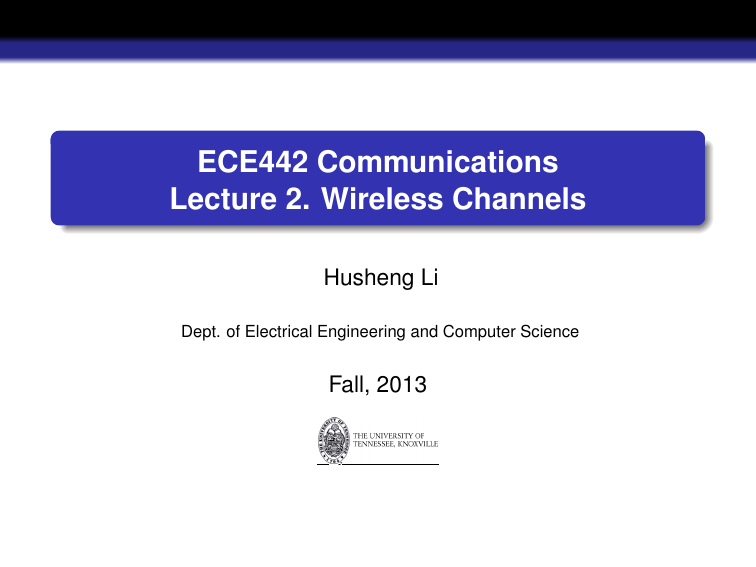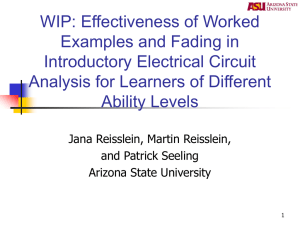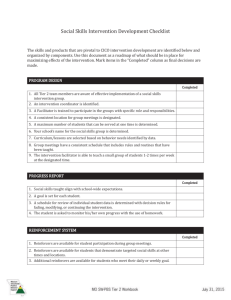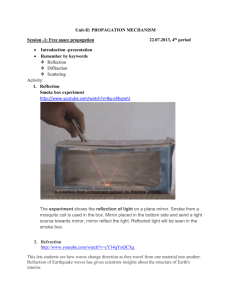ECE442 Communications Lecture 2. Wireless Channels
advertisement

ECE442 Communications Lecture 2. Wireless Channels Husheng Li Dept. of Electrical Engineering and Computer Science Fall, 2013 Two Features of Wireless Channels 1 Broadcast: The wireless signal can also be received by unintended receivers, thus being interference. This is different from wired communications. Thus, in wireless communications, how to tackle interference is a key issue. 2 Fading: the wireless channel may experience deep fade in time or frequency. Thus, in wireless communications, it is important to combat fading for reliable data transmission. Fading can also be utilized for opportunistic communication. Two Types of Fading Large scale fading: characterize the signal strength over long transmitter-receiver distance (you may need to move 100 meters to see the change of signal strength). Small scale fading: characterize the rapid fluctuation over a small distance (you may need to move only half a meter to see the signal strength changing rapidly). Transmit and Receive Signal Model 1 Wireless communication usually uses UHF (0.3 - 3GHz) and SHF (3 - 30GHz). 2 Transmit signal: real sinusoid h i s(t) = < u(t)e2jπfc t , where u(t) is complex baseband signal u(t) = I(t) + jQ(t), which conveys information and fc is carrier frequency. 3 Receive signal: h i r (t) = < v (t)e2jπfc t , where v (t) is received baseband signal v (t) = u(t) ? c(t) and c(t) is channel response. Doppler Shift The Doppler frequency is given by fD = v λ cos θ. Channel Gain and Path Loss Channel Gain and Path Loss 1 Channel power gain is given by G = 10 log10 Pr (dB), Pt where transmit power is Pt and receive power is Pr . 2 Path loss is defined by L = 10 log10 Pt (dB), E [Pr ] where the expectation is over all random environment (shadow fading, fast fading). Path loss is fixed for all time and all environment. Free-space Path Loss 1 Line-of-sight (LOS): no obstructions between the transmitter and receiver. 2 Path loss: Pr = pt !2 p Gl λ , 4πd where Gl is antenna product of transmitter and receiver. 3 In free-space, L ∝ d 2. 4 But in real-world environment, wireless signal decays faster in distance. Two-Ray Model 1 When h1 , h2 d, the receive power is given by Pr (dB) = Pr (dB)+10 log10 (Gl )+20 log10 (h1 h2 )−40 log10 (d). 2 In this case, the signal decays much faster than free-space case: L ∝ d 4 . Two-Ray Model 1 When h1 , h2 d, the receive power is given by Pr (dB) = Pr (dB)+10 log10 (Gl )+20 log10 (h1 h2 )−40 log10 (d). 2 In this case, the signal decays much faster than free-space case: L ∝ d 4 . Critical Distance 1 2 3 When d is not much larger than ht and hr , there could be fluctuations. The critical distance is the distance after which the signal power falls off proportionally to d −4 . An approximation is dc = 4ht hr /λ. Complicated Model 1 General ray tracing 2 Empirical path-loss model 3 Olumura model 4 Hata model 5 Piecewise linear model Hata Model 1 Hata Model (for urban environment): L(dB) = 69.55 + 26.16 log10 (fc ) − 13.82 log10 (ht ) − a(hr ) + (44.9 − 6.55 log10 (ht )) log10 (d), where a(hr ) is a correction factor for the mobile height based on the size of coverage area. 2 For suburban and rural propagation, the path loss should be corrected (refer to Goldsmith’s book). 3 Note: Hata model is used for outdoor wireless communications. Model of Indoor Path Loss 1 When local area network (say, WiFi) is widely used, more communications happen indoors. The penetration loss of barriers (partitions, floors, et al): L = L0 + Nf X i=1 FAFi + Np X PAFi , i=1 where FAFi and PAFi represent penetration losses of floors and partitions, respectively. Shadow Fading 1 Wireless signal often experience variation caused by blockage (say buildings) in the signal path. The variation may also come from changes in reflecting surfaces and scattering objects. We call it shadow fading. 2 We usually model the shadow fading channel gain as a log-normal random variable (then the shadow fading channel gain in dB is a Gaussian random variable: " # (10 log10 ψ − µpsidB )2 ξ p(ψ) = √ exp − 2σψ2 dB 2πσψdB ψ Path Loss and Shadow Fading 1 When the path loss and shadow fading are combined, the ratio of received to transmitted power in dB is given by Pr d dB = 10 log10 K − 10γ log10 − ψdB . Pt d0 2 The outage probability is the probability that the received power at a given distance d the received power is below a threshold: Pout = P(Pr (d) ≤ Pmin ). Cell Coverage: Definition 1 The cell coverage are is a cellular system is defined as the expected percentage of locations within a cell where the received power at these locations is above a given minimum. Cell Coverage: Randomness 1 All mobiles within the cell require some minimum signal-to-noise ratio (SNR). 2 The transmit power at the base station is designed for an average received power at the cell boundary P̄R . 3 The shadowing may make some locations within the cell to have received power below P̄R . Cell Coverage: Computation 1 We define the cell coverage area as Z 1 C=E 1(P(r ) > Pmin in dA)dA . πR 2 cellarea 2 We can prove 1 C = + exp 2 2 b2 2 Q , b where the definition of b can be found in the textbook. Homework 1 1 Problem 1. Use Matlab to implement the calculation of Eq. (2.12) in the textbook, and plot Figure 2.5 (especially when d is not large). Attach the Matlab codes and the figure. 2 Problem 2. Implement Matlab to calculate the cell coverage in Eq. (2.61). Plot the curve of the cell coverage as a function of the decay exponent γ. Plot another curve of the cell coverage as a function of the shadow fading variance σψdB . 3 Deadline: Sept. 9, 2013. Small Scale Fading: Multipath Fading 1 Path loss and shadowing are both large scale, which means that it does not change much if the location of received is not much changed. 2 There also exists small scale fading, which changes radically if the location is slightly changed. Single Path Signal with Moving Receiver 1 The received signal is given by r (t) = < [α(t)u(t) exp(j2πfc (t − τ (t)) + φD )] , where α(t) is amplitude, τ (t) is delay R (time required from transmitter to receiver) and φD = t 2πfD (t)dt is Doppler phase shift (when receiver is moving, the carrier frequency is shifted by fD (t) = v cos(θ)t/λ). 2 The terms α(t), τ (t) and φD (t) changes slowly when the receiver moves. We can consider them as constants in a short period. Resolvable Paths 1 Small scale fading results from multiple replicas of signal along multiple propagation paths (τl means the delay along the l-th path). 2 For two paths 1 and 2, if |τ1 − τ2 | is much smaller than a signal symbol interval (approximately equalling to inverse bandwidth B −1 ), these two paths cannot be distinguished (unresolvable); if |τ1 − τ2 | is much larger than a signal symbol interval, these two paths can be distinguished (resolvable). Narrowband and Wideband Systems 1 In narrowband system, there are very few resolvable paths. Each resolvable signal components may be the superposition of several paths. The destruction or construction effect of these paths can change rapidly in the scale of wavelength. 2 In wideband systems, resolvable signal component may contain only one path, whose amplitude changes slowly when the location of transmitter changes. Narrowband Fading Signal 1 The received signal through a fading channel in a narrowband system is given by (suppose that there is only one resolvable path and no LOS path) " !# X j2πfc t −jφn (t) r (t) = < u(t)e αn (t)e , n where n is the index of unresolvable paths, αn (t) is amplitude and φn (t) = 2πfc τn (t) − φDn − φ0 is phase. 2 The above signal can be decomposed into in-phase and quadrature components: r (t) = rI (t) cos(2πfc t) − rQ (t) sin(2πfc t). Rayleigh Fading 1 2 3 If there are sufficiently many unresolvable paths and no LOS path, the two components rI (t) and rQ (t) are mutually independent Gaussian variables (recall central limit theorem). Then, it is called Rayleigh fading. The distribution of signal amplitude r is (σ 2 is a parameter related to the variance) r2 r ∀r ≥ 0 f (r ) = 2 exp − 2 , σ 2σ and the signal phase is a uniform random variable in [0, 2π]. The amplitude and phase are mutually independent. The signal power is an exponentially distributed random variable (why?). Rayleigh fading is bad since there may exist very deep fade (very small receive signal power). Ricean Fading 1 If there exists a LOS path (a constant component of the signal), the received signal satisfies Ricean distribution: Ar r − r 2 +A2 2 , p(r ) = 2 e 2σ I0 σ σ2 where A is amplitude of the LOS path signal and I0 is modified Bessel function of the first kind and zero-order. 2 Ricean fading has no deep fade if the LOS component is large enough. Rayleigh and Ricean 1 Rayleigh fading is named after Lord Rayleigh, who discovered the Rayleigh scattering (Nobel Prize in 1904). 2 Ricean fading is named after Stephen O. Rice, who is a pioneer of mathematical analysis of random noise and discovered Rice distribution. Wideband Channel Model 1 When the signal is not narrowband, we get another form of distortion due to the multipath delay spread. Deterministic Scattering Function 1 We denote by c(τ, t) the impulse response of the time-varying channel. 2 We define the deterministic scattering function as Z ∞ Sc (τ, ρ) = c(τ, t)e−j2πρt dt. −∞ 3 The Doppler characteristics of the channel is captured by the parameter ρ. Random Channel Case: Autocorrelation Function 1 When c(τ, t) is random, we can define the autocorrelation function Ac (τ1 , τ2 ; t, δt) = E [c ∗ (τ1 , t)c(τ2 , t + δt)] . 2 Usually, we assume that the above autocorrelation is independent of the time, thus can be written as Ac (τ1 , τ2 ; δt). 3 We further assume that the autocorrelation is zero when τ2 6= τ1 . Then, we write it as Ac (τ, δt). Random Channel Case: Scattering Function 1 We define the scattering function as Z ∞ Ac (τ, δt)e−j2πρδt dδt. Sc (τ, ρ) = −∞ Problem 1. Prove that the distribution of received signal power in the Rayleigh fading is exponentially distributed. Problem 2. If σTm = 40ns, what is the maximum symbol rate for the environment such that a linearly modulated signal transmitted through these environments experiences negligible inter-symbol interference? Problem 3. For a channel with Doppler spread Bd = 50Hz, what time separation is required in samples of the received signal such that the samples are approximately independent? Power Delay Profile 1 We call Ac (τ, 0) the power delay profile. 2 We define the average and rms delay spread as R∞ τ Ac (τ )dτ µ = R0 ∞ , 0 Ac (τ )dτ and sR σ= 3 ∞ 0 (τ R − µ)2 Ac (τ )dτ , ∞ 0 Ac (τ )dτ The time delay T when Ac (τ ) ≈ 0 for τ ≥ T can be used to roughly characterize the delay spread. Coherence Bandwidth 1 We define Z ∞ C(f , t) = c(τ, t)e−j2πf τ dτ. −∞ 2 Then, we obtain the autocorrelation given by AC (f1 , f2 , ∆t) = E[C ∗ (f1 , t)C(f2 , t + ∆t)] = AC (∆f , ∆t). 3 We define AC (∆f ) = AC (∆f , 0). Coherence Bandwidth 1 R∞ We can define AC (∆f ) = −∞ Ac (τ )e−j2πδf τ dτ . The frequency Bc where AC (δf ) ≈ 0, for all δf > Bc , is called the coherence bandwidth of the frequency spectrum. Coherence Bandwidth 1 The coherence bandwidth Bc means that the channel responses at two frequency points having separation less than Bc are correlated. 2 We have Bc ≈ 1/T where T is the delay spread. Coherence Time 1 2 To characterize R ∞the Doppler effect, we define SC (∆f , ρ) = −∞ AC (∆f , δt)e−j2πρδt dδt R∞ We define SC (ρ) = SC (0, ρ) = −∞ AC (δt)e−j2πρδt dδt. We define the channel coherence time Tc to be the range of the time over which AC (δt) is approximately nonzero. Coherence Time 1 We call SC (ρ) the Doppler power spectrum and call its bandwidth (BD ) as the Doppler spread of the channel. 2 Approximately, we have BD ≈ 1/Tc , which measures how fast the channel changes with time. Frequency Flat and Selective Fading Channels 1 When the coherence bandwidth is much larger than the signal bandwidth, the signals at different frequencies experience similar fading, called frequency flat fading. 2 When the coherence bandwidth is much smaller than the signal bandwidth, the signals at different frequencies may experience completely different fading, called frequency selective fading. 3 Impact on communication systems: in frequency flat fading, dead once deep fade; in frequency selective fading, there are always some frequencies being at good state, thus adding robustness. But troublesome equalization is required for frequency selective systems. Frequency Flat Signal Model 1 The fading channel just scales the received signal: r (l) = a(l)s(l) + n(l), where r (l) is complex received signal, a(l) is complex channel gain, s(l) is transmitted signal, n(l) is noise (assumed to be AWGN) and l is sample index. 2 Fast fading: a(l) changes with l. 3 Slow fading: a(l) is almost a constant over a period. Frequency Selective Signal Model 1 Multipath model (M paths): r (l) = M X am (l)s(l − τm ) + n(l). m=1 2 FIR model (delay spread N = τM ): r (l) = N X am s(l − m) + n(l) m=1 = a ? s(l) + n(l). 3 In frequency domain, we have R(l) = A(l)S(l) + N(l), where l is index for frequency point (flat fading on different frequencies). Both models are used widely in research. They are equivalent if some coefficients in FIR model are set to 0.




